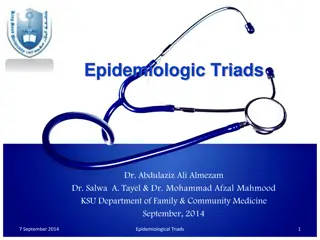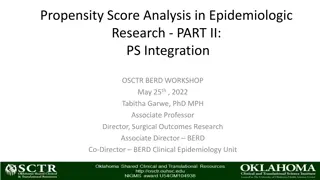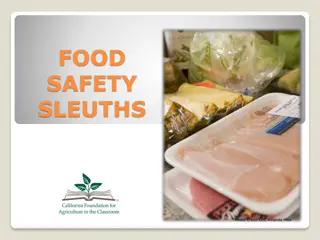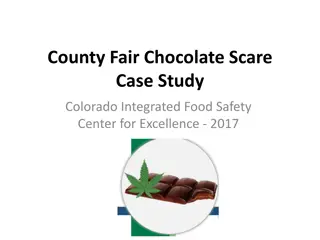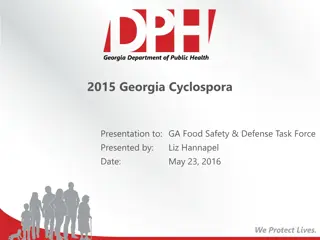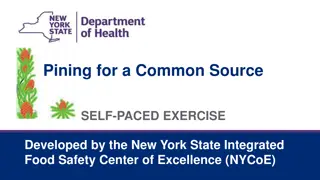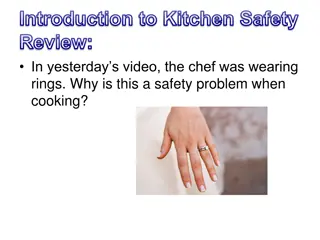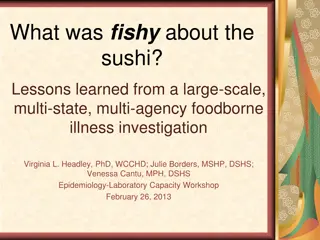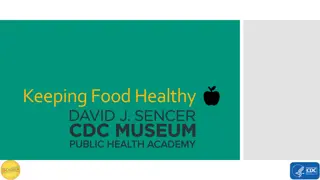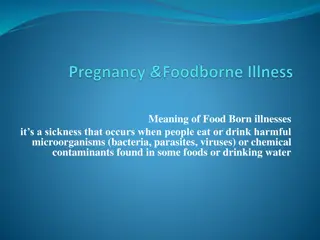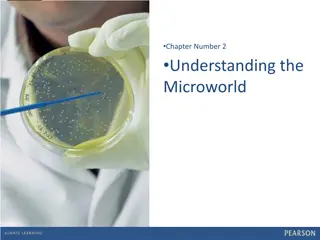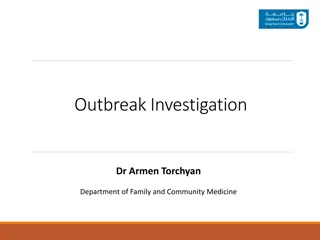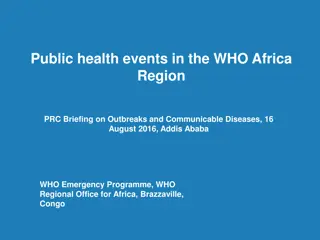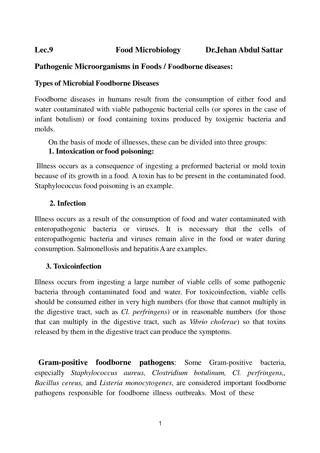Epi-Ready: Investigating Foodborne Outbreaks & Epidemiologic Approaches
In Module 6 of the Epi-Ready Epidemiologic Investigation series, participants learn about epidemiologic approaches in responding to foodborne outbreaks. The module covers methods for information gathering, measures of association, statistical significance, case definitions, surveillance activities, hypothesis generation, and cross-disciplinary investigations involving environmental and laboratory aspects. Key components include case finding, hypothesis generation, and building case definitions to identify and control outbreaks effectively.
Download Presentation

Please find below an Image/Link to download the presentation.
The content on the website is provided AS IS for your information and personal use only. It may not be sold, licensed, or shared on other websites without obtaining consent from the author.If you encounter any issues during the download, it is possible that the publisher has removed the file from their server.
You are allowed to download the files provided on this website for personal or commercial use, subject to the condition that they are used lawfully. All files are the property of their respective owners.
The content on the website is provided AS IS for your information and personal use only. It may not be sold, licensed, or shared on other websites without obtaining consent from the author.
E N D
Presentation Transcript
Epi-Ready EPIDEMIOLOGIC INVESTIGATION Module 6
Module Objectives By the end of this module, participants will be able to evaluate the epidemiologic approaches used in an effective foodborne outbreak response. Recognize the various methods used to gather information during an investigation. Describe the measures of association calculated during an epidemiologic investigation. Explain the concept of statistical significance as it relates to measures of association. 6-2
The Epidemiologic Investigator Conducts Surveillance Activities Identifies and Interviews Cases Generates Hypothesis and Case Definitions Identifies Comparison Groups (Controls) Conducts Analytic Studies 6-3
Cross-Disciplinary Activities Focus Environmental Assessment Activity Product Tracing Environmental Investigator Identify Appropriate Clinical Samples for Collection and Analysis Laboratory Investigator 6-4
Case Definition Uniform criteria employed to define a case Based on the best available information at the time Subject to change Will include: Person Place Time Clinical Criteria 6-5
Building a Case Definition Person: Attended a bar-b-que on July 4th Place: Great Bear Wilderness Club Time: Illness onset July 6th or later Clinical Criteria: Anyone with diarrheal illness (3 or more loose stools in the past 24 hours) A case associated with this outbreak is a person attending a Bar-B-Que on July 4th at the Great Bear Wilderness Club with diarrheal illness with onset July 6th or later. 6
Case Finding Coordination Between Response Team Credit Card Receipts Guest Lists Loyalty Card Information On-line Complaints Media Releases 4-7
Hypothesis Generation A suggested explanation of what is making people sick Ongoing process subject to change Testing hypothesis may require a multidisciplinary approach Food and environmental surface laboratory analysis Product tracing activities by environmental health Additional epidemiologic investigation activities Hypothesis-generating questionnaires 4-8
Hypothesis-Generating Questionnaires Consumption of foods from a standard list Meals consumed during the time of likely exposure Food shopping habits Travel during the time of likely exposure Consumption of food away from the home Restaurant Events Likely exposure period 4-9
Challenges of Hypothesis Generation Poor recall due to time lag from onset of illness to interview Ingredient-level contaminated food (stealth food items) Foods with high consumption rates Foods not disclosed due to their sensitive nature (illegal substances) Interview fatigue of the interviewer and interviewee 4-10
Supportive Tools for Hypothesis Generation and Testing https://www.oregon.gov/oha/ph/DiseasesConditions/CommunicableDisease/Outbreaks/Gastroenteritis /Pages/Outbreak-Investigation-Tools.aspx 4-11
Interpretation of Gathered Information Line Lists Epi Curves Spot Maps 6-12
Activity Working in pairs or in your table group, answer the questions in the participant manual. This activity should take no more than 5 minutes. 13
Epi Curves Visually depicts the time element associated with illness onset May provide a pattern of onsets that can lead to better understanding of how the illness was contracted Point Source Continuous Common Source Propagated 4 3 Number of Cases 2 1 0 13-Jan 14-Jan 15-Jan 16-Jan 17-Jan Date of Onset 6-14
Point Source Outbreak Exposure to same source over brief time Cases rise rapidly to a peak and fall off gradually Majority of cases within one incubation period 40 35 30 Number of Cases 25 20 Exposure 15 10 5 0 1-13 1800 Hrs 1-14 0000 Hrs 1-14 0600 Hrs 1-14 1200 Hrs 1-14 1800 Hrs 1-15 0000 Hrs 1-15 0600 Hrs Time and Date of Onset 6-15
Continuous Common Source Outbreak Exposure to same source over a prolonged time Epidemic curve usually rises gradually Curve may flatten 14 Recall 12 Number of Cases 10 8 6 4 2 0 Date of Onset 6-16
Propagated Outbreak Spread from person to person Often the series will have progressively taller peaks Peaks one incubation period apart 16 14 Number of Cases 12 10 8 6 4 2 0 12-Feb 14-Feb 16-Feb 18-Feb 20-Feb 22-Feb 24-Feb 26-Feb 28-Feb 2-Mar 4-Mar 6-Mar 8-Mar 10-Mar 12-Mar 14-Mar 16-Mar 18-Mar Date of Onset 6-17
Spot Maps Distribution of Cases Reveals Clues Regarding the Source of the Outbreak Over broad area: commercial product with wide distribution Clustering: locally sold product, point source, or person-to-person spread Concentrated areas with outliers: travel to affected area or importation of product ** Bars represent cases 6-18
Epidemiologic Studies- Understanding Association Case Series Cohort Study Case-Control Study Case-Case Comparison 6-19
Case Series Detailed Examination of Cases No Supported by Other Disciplines Comparison Group 6-20
Multistate Outbreak of Salmonella Enteritidis Using shopper card information, it was determined that 7 of 9 cases bought Turkish pine nuts from chain store the week before onset of illness Background rate: <1% of all shoppers bought Turkish pine nuts at store in previous six months Lab testing identified outbreak strain of S. Enteritidis in pine nuts/pesto from store. Strain was indistinguishable to the clinical isolates Store and producer voluntarily recalled pine nuts 6-21
Cohort Study Analytic Study in a Well-defined Group (Cohort) Compares Attack Rates of People Exposed Against People That Were Not Exposed to a Certain Food Illness Ate Food No Illness Cohort Illness Did Not Eat Food No Illness 6-22
Attack Rates Is the Incidence of Disease in a Group of People (Cohort) Food-specific Attack Rates are calculated in the following manner: Number of ill that consumed the food item Total number that consumed the food Item 100 Attack Rate 10 ill persons consumed the salad 20 persons consumed the salad ? 100 6-23
Attack Rate Table Did Not Eat the Food Ate the Food Not ill (b) 18 7 10 8 20 Attack Rate 40% 74% 55% 20% 61% Not ill (d) 10 10 10 5 6 Attack Rate 50% 23% 44% 81% 54% Foods Served Chicken Salad Hamburger Baked Beans Veggie Burger Iced Tea ill (a) 12 20 12 2 31 ill (c) 10 3 8 22 7 6-24
Relative Risk Measure of association for a cohort study Answers: How much more likely is it for people who ate the food to become ill than people who did not eat the food? Relative Risk attack rate among exposed attack rate among unexposed 6-25
Interpreting Relative Risk Close to 1.0: risk of disease is similar among people eating and not eating the food food not associated with illness Greater than 1.0: risk of disease is higher among people eating the food than people not eating the food food could be risk factor Less than 1.0: risk of disease is lower among people eating the food than people not eating the food food could be inversely associated with Magnitude of Relative Risk reflects strength of association between eating food and illness. 6-26
Attack Rate Table with Relative Risks Did Not Eat the Food Ate the Food Relative Risk Foods Served ill (a) Not ill (b) Attack Rate ill (c) Not ill (d) Attack Rate Chicken Salad 12 18 40% 10 10 50% 0.80 Hamburger 20 7 74% 3 10 23% 3.21 Baked Beans 12 10 55% 8 10 44% 1.23 Veggie Burger 2 8 20% 22 5 81% 0.25 Iced Tea 31 20 61% 7 6 54% 1.13 6-27
Case-Control Study Cases (people with illness) and controls (people with no illness) Compare foods eaten by cases and controls Foods more commonly eaten by cases than controls might be associated with illness Ate Food Cases Did Not Eat Food Population at Risk Ate Food Controls Did Not Eat Food 6-28
Odds Ratio Measure of association for a case-control study Answers: How much higher is the odds of eating the food among cases than controls? odds of eating food among cases odds of eating food among controls odds ratio = 6-29
Botulism Outbreak In Vancouver B.C. 36 cases of botulism among patrons of Restaurant X Case-control study undertaken 20 (91%) of 22 cases ate beef dip sandwich 3 (14%) of 22 controls ate beef dip sandwich 6-30
Determining the Odds Ratio 20 of 22 cases ate beef dip sandwich (2 didn t) 3 of 22 controls ate beef dip sandwich (19 didn t) odds of eating food (cases) 20/2 odds of eating food (controls) 3/19 odds ratio = odds ratio = 63 An odds ratio of 63 means the odds that cases ate the beef dip sandwich was 63 times higher than the odds among controls. Eating the beef dip sandwich might be a risk factor for botulism in this outbreak. 6-31
Interpreting Odds Ratios Close to 1.0: odds of eating food is similar among cases and controls no association between food and illness Greater than 1.0: odds of eating food among cases is higher than among controls food could be risk factor Less than 1.0: odds of eating food among cases is lower than among controls food could be inversely associated Magnitude reflects strength of association between illness and eating the food. 6-32
Case-Case Study Design Yields odds ratio similar to case-control studies depending on risk factors under investigation May eliminate the need to match controls Reduces selection and recall bias Saves valuable resources as case-patients are interviewed as part of an effective surveillance program 6-33
Choosing a Study Design Case series when the number of cases is small (generally less than five) and no controls are available Cohort study when investigators can easily identify the population at risk (i.e., outbreak has occurred in a well-defined group) and the population at risk can be enumerated Case-control study when the population at risk (people potentially exposed to source of outbreak) is unknown or cannot be enumerated or the illness is rare 6-34
Statistical Significance Odds ratios and relative risks are estimates Observed results could be due to chance alone Role of chance explored through Confidence interval (CI) p-value 6-35
Confidence Intervals Range of values for the measure of association that are consistent with study findings Has specified probability of including true value for the measure of association. Generally a probability of 95% is used. Positive association when range of values are greater than 1.0 Inverse association when range of values between 0 and 1.0 Ranges that include 1.0 are not significant! 6-36
Confidence Intervals of the Cohort Study Did Not Eat the Food Confidence Interval Ate the Food Not ill (b) Attack Rate Not ill (d) Attack Rate Relative Risk Lower Limit Upper Limit Foods Served ill (a) ill (c) Chicken Salad 12 18 40% 10 10 50% 0.80 0.43 1.48 Hamburger 20 7 74% 3 10 23% 3.21 1.16 8.88 Baked Beans 12 10 55% 8 10 44% 1.23 0.64 2.33 Veggie Burger 2 8 20% 22 5 81% 0.25 0.07 0.86 Iced Tea 31 20 61% 7 6 54% 1.13 0.65 1.96 6-37
P-Value Probability that findings due to chance alone Ranges from 0 to 1.0 (0% to 100%) Closer to 1.0 (100%) high probability the findings are due to chance Closer to 0.0 (0%) low probability the findings are due to chance p-value = 0.02 Interpretation: the probability of the finding occurred by chance is 2 in 100 times 6-38
P-Values Calculated for Attack Rate Table Did Not Eat the Food Ate the Food Attack Rate Attack Rate Relative Risk Foods Served ill (a) Not ill (b) ill (c) Not ill (d) p-value Chicken Salad 12 18 40% 10 10 50% 0.80 0.48 Hamburger 20 7 74% 3 10 23% 3.21 0.002 Baked Beans 12 10 55% 8 10 44% 1.23 0.53 Veggie Burger 2 8 20% 22 5 81% 0.25 0.0005 Iced Tea 31 20 61% 7 6 54% 1.13 0.65 6-39
Summary Recognize the various methods use to gather information during an investigation Describe the measures of association calculated during an investigation Explain the concept of statistical significance as it relates to measures of association 6-40
Coming Up Next Environmental Investigation 6-41



